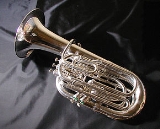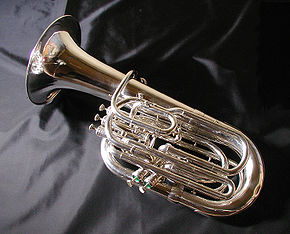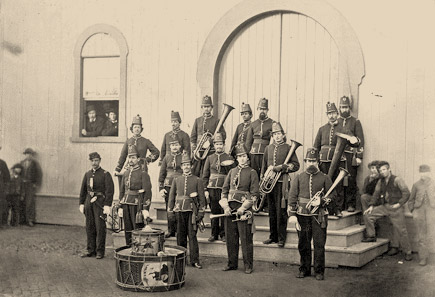
Saxhorn
Encyclopedia

Brass instrument
A brass instrument is a musical instrument whose sound is produced by sympathetic vibration of air in a tubular resonator in sympathy with the vibration of the player's lips...
with a conical bore and deep cup-shaped mouthpiece
Mouthpiece (brass)
On brass instruments the mouthpiece is the part of the instrument which is placed upon the player's lips. The purpose of the mouthpiece is a resonator, which passes vibration from the lips to the column of air contained within the instrument, giving rise to the standing wave pattern of vibration in...
. The sound has a characteristic mellow quality, and blends well with other brass.
The saxhorn family
The saxhorns form a family of seven instruments (although at one point ten different sizes seem to have existed). Designed for band use, they are pitched alternately in E-flat and B-flat, like the saxophoneSaxophone
The saxophone is a conical-bore transposing musical instrument that is a member of the woodwind family. Saxophones are usually made of brass and played with a single-reed mouthpiece similar to that of the clarinet. The saxophone was invented by the Belgian instrument maker Adolphe Sax in 1846...
group.
There is much confusion as to nomenclature of the various instruments in different languages. This has been exacerbated by the debate as to whether the saxhorn family was truly new, or rather a development of members of the previously existing cornet
Cornet
The cornet is a brass instrument very similar to the trumpet, distinguished by its conical bore, compact shape, and mellower tone quality. The most common cornet is a transposing instrument in B. It is not related to the renaissance and early baroque cornett or cornetto.-History:The cornet was...
and tuba
Tuba
The tuba is the largest and lowest-pitched brass instrument. Sound is produced by vibrating or "buzzing" the lips into a large cupped mouthpiece. It is one of the most recent additions to the modern symphony orchestra, first appearing in the mid-19th century, when it largely replaced the...
families. The saxhorn is also commonly confused with the flügelhorn
Flugelhorn
The flugelhorn is a brass instrument resembling a trumpet but with a wider, conical bore. Some consider it to be a member of the saxhorn family developed by Adolphe Sax ; however, other historians assert that it derives from the valve bugle designed by Michael Saurle , Munich 1832 , thus...
, a German
Germany
Germany , officially the Federal Republic of Germany , is a federal parliamentary republic in Europe. The country consists of 16 states while the capital and largest city is Berlin. Germany covers an area of 357,021 km2 and has a largely temperate seasonal climate...
instrument which has a different configuration and predates the saxhorn. This confusion is not helped by the fact that most instruments referred to today as flügelhorns are actually soprano saxhorns. If a modern 'flügelhorn' bell has a flare similar to the one shown on the larger saxhorn pictured here, then it may indeed be a soprano saxhorn, but if the conical bell is nearly the diameter of the bell rim until just before a small final flare, then it is a true flügelhorn.
The following table lists the members of the saxhorn family as described in the orchestration texts of Hector Berlioz
Hector Berlioz
Hector Berlioz was a French Romantic composer, best known for his compositions Symphonie fantastique and Grande messe des morts . Berlioz made significant contributions to the modern orchestra with his Treatise on Instrumentation. He specified huge orchestral forces for some of his works; as a...
and Cecil Forsyth
Cecil Forsyth
Cecil Forsyth was an English composer and musicologist. He was born in Greenwich on November 30, 1870, and he died in New York on December 7, 1941. He studied at Edinburgh University and at the Royal College of Music , and played viola in various London Orchestras...
, the J. Howard Foote catalog of 1893, and modern names.
| Foote | Berlioz | Forsyth | Modern |
|---|---|---|---|
| --- | Sopranino in C/B-flat | --- | --- |
| --- | Soprano in E-flat | Sopranino in E-flat | Sopranino/Soprano in E-flat |
| --- | Alto in B-flat | Soprano in B-flat | Soprano/Alto in B-flat |
| Alto in E-flat | Tenor in E-flat | Alto in E-flat | Alto/Tenor in E-flat |
| Tenor in B-flat | Baritone in B-flat | Tenor in B-flat | Tenor/Baritone in B-flat |
| Baritone in B-flat | Bass in B-flat | Bass in B-flat | Baritone/Bass in B-flat |
| Bass in E-flat | Contrabass in E-flat | Bass in E-flat | Bass in E-flat |
| Contrabass in E-flat | Contrabass in B-flat | Contrabass in B-flat | Contrabass in B-flat |
| --- | Contrabass in low E-flat | --- | --- |
| --- | Bourdon in B-flat | --- | --- |
Ranges of individual members
The saxhorn is based on the same three-valve system as most other valved brass instruments. Each member of the family is named after the root note produced by the second partialHarmonic series (music)
Pitched musical instruments are often based on an approximate harmonic oscillator such as a string or a column of air, which oscillates at numerous frequencies simultaneously. At these resonant frequencies, waves travel in both directions along the string or air column, reinforcing and canceling...
with no valves actuated. Each member nominally possesses or possessed the typical three-valve brass range from the note one tritone below that root note (second partial, all valves actuated) to the note produced by eighth partial with no valves actuated, i.e., the note two octaves above the root note.
All the modern members of the family are transposing instruments written in the treble clef with the root note produced by the second partial with no valves actuated being written as middle C, though baritone
Baritone horn
The baritone horn is a member of the brass instrument family. The baritone horn has a predominantly cylindrical bore as do the trumpet and trombone. A baritone horn uses a large mouthpiece much like those of a trombone or euphonium, although it is a bit smaller. Some baritone mouthpieces will sink...
often plays bass clef parts, especially those written for the trombone.
History

Adolphe Sax
Antoine-Joseph "Adolphe" Sax was a Belgian musical instrument designer and musician who played the flute and clarinet, and is best known for having invented the saxophone.-Biography:...
. Sax's claim to have invented the instrument was hotly contested by other brass instrument makers during his lifetime, leading to various lawsuits. Throughout the mid-1850s, he continued to experiment with the instrument's valve pattern.
Saxhorns were popularized by the distinguished Distin
Distin
The Distin family was a family of British Musicians in the 19th century who performed on saxhorns and were influential in the evolution of brass instruments in then popular music...
Quintet, who toured Europe during the mid-19th century. This family of musicians, publishers and instrument manufacturers had a significant impact on the growth of the brass band
Brass band (British style)
A British-style brass band is a musical ensemble comprising a standardised range of brass and percussion instruments. The modern form of the brass band in the United Kingdom dates back to the 19th century, with a vibrant tradition of competition based around local industry and communities...
movement in Britain during the mid-to late-19th century.
The saxhorn was the most common brass instrument in American Civil War
American Civil War
The American Civil War was a civil war fought in the United States of America. In response to the election of Abraham Lincoln as President of the United States, 11 southern slave states declared their secession from the United States and formed the Confederate States of America ; the other 25...
bands. The over-the-shoulder variety of the instrument was used, as the backward-pointing bell of the instrument allowed troops marching behind the band to hear the music.
Contemporary works featuring this instrument are Désiré Dondeyne
Désiré Dondeyne
Désiré Louis Corneille Dondeyne is a French conductor, composer, and teacher born in Laon in the Aisne département July 21, 1921.He studied music at the conservatory in Lille and beginning in 1936 at the Conservatoire de Paris. Dondeyne earned first prize in clarinet, chamber music, harmony,...
's "Tubissimo" for bass tuba or saxhorn and piano (1983) and Olivier Messiaen
Olivier Messiaen
Olivier Messiaen was a French composer, organist and ornithologist, one of the major composers of the 20th century. His music is rhythmically complex ; harmonically and melodically it is based on modes of limited transposition, which he abstracted from his early compositions and improvisations...
's "Et exspecto resurrectionem mortuorum" (1984).
See also
- Common members of the saxhorn family found in the modern brass band and having their own article:
- Alto hornAlto hornThe alto horn is a brass instrument pitched in E...
- Baritone hornBaritone hornThe baritone horn is a member of the brass instrument family. The baritone horn has a predominantly cylindrical bore as do the trumpet and trombone. A baritone horn uses a large mouthpiece much like those of a trombone or euphonium, although it is a bit smaller. Some baritone mouthpieces will sink...
- Alto horn
- Article on a closely related instrument:
- FlugelhornFlugelhornThe flugelhorn is a brass instrument resembling a trumpet but with a wider, conical bore. Some consider it to be a member of the saxhorn family developed by Adolphe Sax ; however, other historians assert that it derives from the valve bugle designed by Michael Saurle , Munich 1832 , thus...
- Flugelhorn
Discography
- Saxhorn et piano - Hybrid'Music Label - October 2008
David Maillot, saxhorn - Géraldine Dutroncy, piano - Works by Eugène Bozza, Marcel Bitsch, Jacques Castérède, Alain Bernaud, Henri Tomasi, Claude Pascal, Gérard Devos and Roger Boutry.
14 Volumes of saxhorn band are available featuring The First Brigade Band http://1stbrigadeband.org/1_home.html

